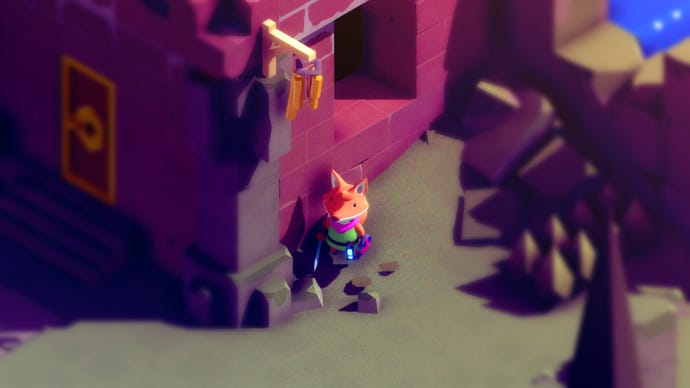A sign of the chimes: Tunic developer explains how one of its best puzzles was made
Tunic is crammed with delightful little moments – but there’s one in particular that stands out, for anyone with a sharp ear.
Tunic is one of the best games I’ve played this year. No, scratch that – it’s one of the best game I’ve played so far this generation. Between some wonderfully oblique puzzles, its own glyph-based language, some tight combat mechanics, and some vaguely sadistic game design, its foxy little head pokes up above the glut of games we’ve had the pleasure of playing since the start of the PS5/Xbox Series generation.
But even within Tunic, there’s one puzzle that stands out. Once you get a certain way into the game, certain skills anb abilities start to become clear to you; it becomes clear that your lupine avatar is capable of more than you first thought. And so combing back over the hostile island you find yourself on becomes not only an attractive prospect – but a necessary one.
-Major spoilers for Tunic follow-
After a few hours of cutting down shrubs, poking at walls, and sniffing around the corners of the world, you’ll unlock one of Tunic’s biggest ‘a-ha!’ moments: the ‘Holy Cross’. Referenced multiple times throughout the adventure game’s in-game booklet, the ‘Holy Cross’ actually refers to your D-Pad. Your little hero can use inputs on the D-Pad to ‘sing’ to the world, so to speak, and interact with objects that would otherwise be useless to you.
This technique is useful for a variety of reasons; it will unlock doors (typically inscribed with runic markings hinting at which buttons you need to press), it will summon fairies (part of an end-game secret that will lead you to the tricky Golden Path), and it will resonate with certain gold items in the world that denote hidden secrets.
You can complete Tunic without looking under the surface, to to speak; the secrets you uncover may grant you extra items, more health, or even open up shortcuts. But a lot of the secrets in the game are dressing to the main story. The world of the game – simply called The Far Shore – is teeming with things to uncover, and even the developer seems to intone that the game still has plenty more tricks left up its sleeve.

My personal favourite is a little secret that isn’t hidden in plain sight – like most of Tunic’s best bits – but rather in plain… sound. At one point in the game, you’ll see a set of wind chimes hanging off an old building. Innocuous enough at first, but once you learn about the ‘Holy Cross’ and see that other golden items in the game have some significance… well, you start to open your ears, as well as your eyes.
“Tunic lead Andrew Shouldice and I have been a big fan of audio puzzles for a long time,” explains audio lead, Kevin Regamey. “Way back in the day (2012), I designed and released a game called Phonopath, which you can't play anymore, because Flash is no longer a thing. But it was an audio puzzle game, based in the browser, where you download audio files and find hidden passwords by turning the parts through spectral analysis and cryptography and phase cancellation – all these audio things, basically.”
Regamey tells us that, before development on Tunic began, Shouldice was aware of his work, and sought him out for the fox-based adventure game. It’s no surprise, really; Shouldice wanted secrets in this game, and Regamey made a game all about sequestering solutions away in sounds. It was a match made in heaven.
“Tunic is all about just hiding stuff everywhere you possibly can, right?” says Regamey. “So the idea of having wind chimes, I think very early on, was an idea that I pitched. Just having some chimes hanging out somewhere in the world that are just there – you see them and you think ‘they’re not important, let’s just keep walking’.
“And then maybe later on, maybe once you realise that there are hit there are secrets hidden in plain site – all over the world – you come back and realise ‘ah, I saw that in the manual, actually!’”

Regamey is referring the in-game booklet that tells you about the ‘Holy Cross’ and has some (very oblique) hints about where to find the game’s 12 most obscure secrets. On page 28, there’s a tiny little scribbled music note, pointing roughly to the location of the chimes. On page 34, there’s a small bird scribbled down with musical notes drawn on to correspond to the sound the chimes make. From there, you’d need to use your brain – and a good ear for music – to figure out the rest of the puzzle. You need to key in directional arrows to match the noise the chimes make in order to unlock the secret. Sound complicated? It is. But it was even harder to make.
“We're using FMOD Studio, [a proprietary sound effects engine and authoring tool], on the audio side of things,” explains Regamey. “It's a wonderful little tool that lets me, the audio lead, basically set up certain audio behaviour so that playback – start-to-finish; the whole phrase that dictates the secret input sequence you need to put in – is semi-random. So it I set up a whole system in FMOD, such that the the pairings of chimes always play in the correct sequence of structure. It can randomise the timing between notes into given pair, it can randomise the time between pairs on the whole, it can randomise which chimes play (because it is modelled as four physical chimes, right?)
“So basically, if a note sequence needs to go high, then low, there are only so many options for going high into low. It plays one of those options basically, and there's a little pause and does it all over again.”

The whole idea was pitched early pitch by Regamey giving Shouldice the concept as a vague idea, before the lead dev helped to frame it as a wind-chime puzzle, and fit it into Tunic’s world as this obscure, blink-and-you’ll-miss-it take on adventure game secrets.
The puzzle is easier to solve if you turn all the music down via the settings and just have the sound effects on, instead. But there’s also an accessibility issue with it; sound-based puzzles lock out certain parts of the gaming community from being able to solve them, but Shouldice tells us that, in an upcoming patch, “we have some accessibility options to alleviate this audio-only puzzle”.
And that’s for the best, because this little puzzle is one of the best bits of a game brimming with best bits. And it’d be a crying shame if you couldn’t unlock the windchime puzzle – and the unsettling end-game secret it leads to – just because you were unable to hear it.









